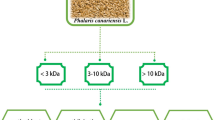Abstract
The prevalence of diabetes has become a huge health burden in parts of quality of life and economic cost for overcoming this chronic disease. We followed a bioactivity-guided isolation using α-glucosidase inhibitory assay, four major compounds were isolated, and their structures were elucidated using nuclear magnetic resonance, mass spectrometry, and ultra-performance liquid chromatography quadrupole time of flight mass spectrometry in litchi seed. As a result, the IC50 of α-glucosidase inhibitory assay of the crude extract, sugar-removed layer, pavetannin B2, procyanidin A2, and acarbose was 0.691 μg/mL, 3.686 μg/mL, 0.04 μM, 0.08 μM, and 55.845 μg/mL, respectively. With those compounds, we examined the protein tyrosine phosphatase 1B inhibitory activity. And the IC50 of pavetannin B2, procyanidin A2, and ursolic acid was 450.295, 338.257, and 19.686 μM, respectively. Contents analysis method for bioactive compounds, which can be used in manufacturing for extract preparations, was established. The findings of this study, litchi seed can be a cost-effective medicinal food in terms of recyclable resources in the litchi food industry and as a natural alternative medicine against type-2 diabetes.




Similar content being viewed by others
References
McAdam MC (2013) Economic implications of type 2 diabetes management. Am J Manag Care 19:S143–S148
Whiting DR, Guariguata L, Weil C, Shaw J (2011) IDF diabetes atlas: global estimates of the prevalence of diabetes for 2011 and 2030. Diabetes Res Clin Pract 94:311–321
Casirola DM, Ferraris RP (2006) α-glucosidase inhibitors prevent diet-induced increases in intestinal sugar transport in diabetic mice. Metabolism 55:832–841
Van De Laar FA, Lucassen PL, Akkermans RP, Van De Lisdonk EH, Rutten GE, Van Weel C (2005) α-glucosidase inhibitors for patients with type 2 diabetes results from a cochrane systematic review and meta-analysis. Diabetes Care 28:154–163
Klaman LD, Boss O, Peroni OD, Kim JK, Martino JL, Zabolotny JM, Moghal N, Lubkin M, Kim YB, Sharpe AH (2000) Increased energy expenditure, decreased adiposity, and tissue-specific insulin sensitivity in protein-tyrosine phosphatase 1B-deficient mice. Mol Cell Biol 20:5479–5489
Delibegović M, Mody N (2009) Protein tyrosine phosphatase 1B (PTP1B) in obesity and type 2 diabetes. Acta Med Salin 38:2–7
Saxena S, Hajare SN, More V, Kumar S, Wadhawan S, Mishra B, Parte MN, Gautam S, Sharma A (2011) Antioxidant and radioprotective properties of commercially grown litchi (Litchi chinensis) from India. Food Chem 126:39–45
Nagle MA, Marcus HK, Mahayothee BU, Haewsungcharern ME, Janjai SE, Müller JO (2011) Fruit processing residues as an alternative fuel for drying in Northern Thailand. Fuel 90(2):818–823
Wang L, Lou G, Ma Z, Liu X (2011) Chemical constituents with antioxidant activities from litchi (Litchi chinensis Sonn.) seeds. Food Chem 126:1081–1087
Bhat RS, Aldaihan S (2014) Antimicrobial activity of Litchi chinensis Nephelium lappaceum aqueous seed extracts against some pathogenic bacterial strains. J King Saud Univ Sci 26:79–82
Xu X, Xie H, Hao J, Jiang Y, Wei X (2010) Eudesmane sesquiterpene glucosides from lychee seed and their cytotoxic activity. Food Chem 123:1123–1126
Queiroz ER, Abreu CM, Rocha DA, Braga MA (2015) Anti-nutritional compounds in fresh and dried lychee fractions (Litchi chinensis Sonn.). Afr J Agric Res 10:499–504
Hsu CP, Lin CC, Huang CC, Lin YH, Chou JC, Tsia YT, Su JR, Chung YC (2012) Induction of apoptosis and cell cycle arrest in human colorectal carcinoma by Litchi seed extract. J Biomed Biotechnol 2012:1–7
Park TS, Hwang WK (2011) Industry-academic cooperation foundation Yonsei university, 2010 July 02, composition containing litchi seed extract for preventing or treating fatty liver or obesity. World Intellectual Property Organizaion patent, WO2011090271 A3
Shen DC, Fuh MM, Shieh SM, Chen YDI, Reaven GM (1991) Effect of gemfibrozil treatment in sulfonylurea-treated patients with noninsulin-dependent diabetes mellitus. J Clin Endocrinol Metab 73(3):503–510
Li T, Zhang X, Song Y, Liu J (2005) A microplate-based screening method for α-glucosidase inhibitors. Chin J Clin Pharmacol Ther 10:1129
Chowdhury S, Islam M, Jung H, Choi J (2014) In vitro antidiabetic potential of the fruits of Crataegus pinnatifida. Res Pharm Sci 9:11
Wu QL, Wang SP, Du LJ, Wang LW, Yang JS, Xiao PG (1998) Constituents of Hypericum japonicum. Phytother Res 12:S164–S168
López JJ, Jard NI, Salido GM, Rosado JA (2008) Cinnamtannin B-1 as an antioxidant and platelet aggregation inhibitor. Life Sci 82:977–982
Liu L, Xie B, Cao S, Yang E, Xu X, Guo S (2007) A-type procyanidins from Litchi chinensis pericarp with antioxidant activity. Food Chem 105:1446–1451
Shahat AA (2006) Procyanidins from Adansonia digitata. Pharm Biol 44:445–450
Lee YG, Cho JY, Kim CM, Lee SH, Kim WS, Jeon TI, Park KH, Moon JH (2013) Coumaroyl quinic acid derivatives and flavonoids from immature pear (Pyrus pyrifolia Nakai) fruit. Food Sci Biotechnol 22:803–810
Choi JS, Bhakta HK, Fujii H, Min BS, Park CH, Yokozawa T, Jung HA (2016) Inhibitory evaluation of oligonol on α-glucosidase, protein tyrosine phosphatase 1B, cholinesterase, and β-secretase 1 related to diabetes and Alzheimer’s disease. Arch Pharm Res 39:409–420
Seo KH, Ra JE, Lee SJ, Lee JH, Kim SR, Lee JH (2015) Anti-hyperglycemic activity of polyphenols isolated from barnyard millet (Echinochloa utilis L.) and their role inhibiting α-glucosidase. J Korean Soc Appl Biol Chem 58:571–579
Yang X, Kong F (2016) Evaluation of the in vitro α-glucosidase inhibitory activity of green tea polyphenols and different tea types. J Sci Food Agric 96(3):777–782
Tadera K, Minami Y, Takamatsu K, Matsuoka T (2006) Inhibition of alpha-glucosidase and alpha-amylase by flavonoids. J Nutr Sci Vitaminol 52:149–153
Acknowledgments
This research was supported by the Chung-Ang University Graduate Research Scholarship in 2015.
Author information
Authors and Affiliations
Corresponding author
Rights and permissions
About this article
Cite this article
Choi, SA., Lee, J.E., Kyung, M.J. et al. Anti-diabetic functional food with wasted litchi seed and standard of quality control. Appl Biol Chem 60, 197–204 (2017). https://doi.org/10.1007/s13765-017-0269-9
Received:
Accepted:
Published:
Issue Date:
DOI: https://doi.org/10.1007/s13765-017-0269-9




